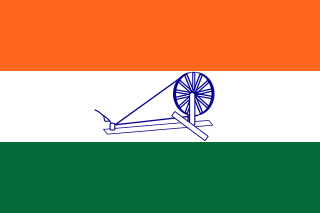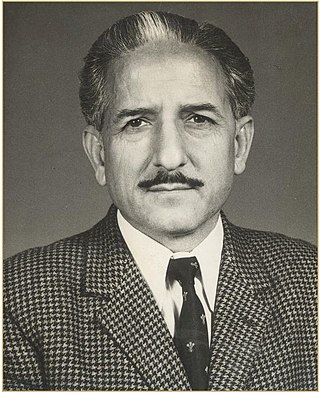Related Research Articles

The Indian National Army was a collaborationist armed unit of Indian collaborators that fought under the command of the Japanese Empire. It was founded on 1 September 1942 in Southeast Asia during World War II.

During the Second World War (1939–1945), India was a part of the British Empire. British India officially declared war on Nazi Germany in September 1939. India, as a part of the Allied Nations, sent over two and a half million soldiers to fight under British command against the Axis powers. India was also used as the base for American operations in support of China in the China Burma India Theater.

The 7th Infantry Division is a war-formed infantry division, part of the British Indian Army that saw service in the Burma Campaign.

The 12th Frontier Force Regiment was formed in 1922 as part of the British Indian Army. It consisted of five regular battalions; numbered 1 to 5 and the 10th (Training) Battalion. During the Second World War a further ten battalions were raised. In 1945, the prenominal "12th" was dropped when the British Indian Army dispensed with prenominal numbering of its regiments. After the independence in 1947, it was formed into the Frontier Force Regiment, part of the army of Pakistan.

The Indian Legion, officially the Free India Legion or 950th (Indian) Infantry Regiment, was a military unit raised during the Second World War initially as part of the German Army and later the Waffen-SS from August 1944. Intended to serve as a liberation force for British-ruled India, it was made up of Indian prisoners of war and expatriates in Europe. Due to its origins in the Indian independence movement, it was known also as the "Tiger Legion", and the "Azad Hind Fauj". As part of the Waffen-SS it was known as the Indian Volunteer Legion of the Waffen-SS.

Shah Nawaz Khan was an Indian politician who served as an officer in the Indian National Army (INA) during World War II. He was profoundly influenced by Subhas Chandra Bose's speeches asking POWs to join the Indian National Army and to fight for a free India, Khan led the army into North-Eastern India, seizing Kohima and Imphal which were held briefly by the INA under the authority of the Japanese. In December 1944, Shah Nawaz Khan was appointed Commander of the 1st Division at Mandalay. After the war, he was tried, convicted for treason, and sentenced to death in a public court-martial carried out by the British Indian Army. The sentence was commuted by the Commander-in-chief of the Indian Army following unrest and protests in India. After the trial, Khan declared that he would henceforth follow the path of non-violence espoused by Mahatama Gandhi and he joined the Congress party. Having successfully contested the first Lok Sabha in 1952 from Meerut, Khan had an illustrious parliamentary career. He was elected four times to the Lok Sabha from Meerut constituency in 1951, 1957, 1962 and 1971. He lost in the 1967 and 1977 Lok Sabha election from Meerut.

The Battle of Pakokku and Irrawaddy River operations were a series of battles fought between the British Indian Army and the Imperial Japanese Army and allied forces over the successful Allied Burma campaign on the China Burma India Theater during World War II. The battles and operations were instrumental in facilitating the eventual capture of Rangoon in summer 1945.

The Indian National Army trials was the British Indian trial by court-martial of a number of officers of the Indian National Army (INA) between November 1945 and May 1946, on various charges of treason, torture, murder and abetment to murder, during the Second World War.

Major General Mohammed Zaman Kiani was an officer of the British Indian Army who later joined the Indian National Army (INA), led by Subhas Chandra Bose, and commanded its 1st Division.
The Hindustan Field Force was the first operational regiment of the Indian National Army that was formed in September 1942 under the first INA. Under the command of J.K. Bhonsle, the unit was formed at Singapore and comprised three battalions derived from troops of the 17th Dogra Regiment, Garhwal Rifles and the 14th Punjab Regiment and had a strength of nearly 2000 troops.
The First Indian National Army was the Indian National Army as it existed between February and December 1942. It was formed with Japanese aid and support after the Fall of Singapore and consisted of approximately 12,000 of the 40,000 Indian prisoners of war who were captured either during the Malayan campaign or surrendered at Singapore. It was formally proclaimed in April 1942 and declared the subordinate military wing of the Indian Independence League in June that year. The unit was formed by Mohan Singh. The unit was dissolved in December 1942 after apprehensions of Japanese motives with regards to the INA led to disagreements and distrust between Mohan Singh and INA leadership on one hand, and the League's leadership, most notably Rash Behari Bose. Later on, the leadership of the Indian National Army was handed to Subhas Chandra Bose. A large number of the INAs initial volunteers, however, later went on to join the INA in its second incarnation under Subhas Chandra Bose.
The Azad Brigade or the 3rd Guerrilla Regiment was a unit of the Indian National Army that formed a part of the First INA and later part of the 1st Division after the INA's revival under Subhas Chandra Bose.
The Nehru Brigade or 4th Guerrilla Regiment was a unit of the Indian National Army, that formed a part of the First INA and later part of the 1st Division after the INA's revival under Subhas Chandra Bose. Subhas Bose named the regiment after Pandit Jawaharlal Nehru, the 1st Prime Minister of India.
The Subhas Brigade, or the 1st Guerrilla Regiment was a unit of the Indian National Army (INA). The unit was formed in 1943 and unofficially referred to as Subhas Brigade after the Indian independence leader Subhas Chandra Bose, who at the time was also the supreme commander of the army. The unit was the first and major commitment of the second INA in the Imphal Offensive, and along with Azad, Gandhi and Nehru Brigade, the Army's contribution to the Imperial Japanese Army's U-go offensive.
The Battles and Operations involving the Indian National Army during World War II were all fought in the South-East Asian theatre. These range from the earliest deployments of the INA's preceding units in espionage during Malayan Campaign in 1942, through the more substantial commitments during the Japanese Ha Go and U Go offensives in the Upper Burma and Manipur region, to the defensive battles during the Allied Burma campaign. The INA's brother unit in Europe, the Indische Legion did not see any substantial deployment although some were engaged in Atlantic wall duties, special operations in Persia and Afghanistan, and later a small deployment in Italy. The INA was not considered a significant military threat. However, it was deemed a significant strategic threat especially to the Indian Army, with Wavell describing it as a target of prime importance.

Lieutenant General Harbaksh Singh, VrC was a senior General Officer in the Indian Army. As the Western Army Commander, Singh commanded the Indian Army forces and played a key role during the Indo-Pakistani War of 1965. For his role in the war, he was awarded the Padma Vibhushan in 1966.
Habib ur Rahman (1913–1978) was an army officer in the Indian National Army (INA) who was charged with "waging war against His Majesty the King Emperor". He served as Subhas Chandra Bose's chief of staff in Singapore, and accompanied Bose on his alleged last fatal flight from Taipei to Tokyo, sharing the last moments of his life. Rahman also played an important role in the First Kashmir War. Convinced that Maharaja Hari Singh was out to exterminate the Muslims of Jammu and Kashmir, he joined Major General Zaman Kiani, in launching a rebellion against the Maharaja from Gujrat in Pakistani Punjab. Rehman and his volunteer force launched an attack on the Bhimber town. But, the records of the 11th Cavalry of the Pakistan Army indicate that their efforts did not succeed, and eventually the Cavalry was responsible for conquering Bhimber.

The 19th Punjabis was an infantry regiment of the British Indian Army. It was raised in 1857, as the 7th Regiment of Punjab Infantry. It was designated as the 19th Punjabis in 1903 and became 1st Battalion 14th Punjab Regiment i.e. 1/14 Punjab Regiment in 1922. In 1947, it was allocated to the Pakistan Army, where it continues to exist as 5th Battalion The Punjab Regiment.
Malik Munawar Khan Awan was a Major rank officer in the Pakistan Army, whose career had begun in the British Indian Army and included spells in the Imperial Japanese Army and the revolutionary Indian National Army that fought against the Allies in World War II where he commanded 2nd INA Guerrilla Battalion during famous Battle of Imphal. He received a gallantry award for his work during Operation Gibraltar in 1965.

Pitri Sharan Raturi (1920–1991) was an officer of the Indian National Army and later, of the Indian Police Service. He commanded the 1st battalion of the INA's 1st Guerrilla Regiment which participated in the battle of the Kaladan River valley in March–April 1944 against the 81st Division of the XV British Corps and forcing retreat of the British forces, entered India to occupy Mowdok, near Chittagong. After the war, Raturi joined the IPS and retired as Principal Director in the Directorate General of Security, the co-agency of the Research and Analysis Wing. Post-retirement, he served in an honorary capacity as Officer on Special Duty (INA) in the Ministry of Home Affairs.
References
- ↑ Singh, Sushant (10 September 2022). "Bose is being shown as counter to Gandhi. He would have rejected the idea". Deccan Herald.
- Fay, Peter W. (1993), The Forgotten Army: India's Armed Struggle for Independence, 1942-1945. Ann Arbor, University of Michigan Press., ISBN 0-472-08342-2
